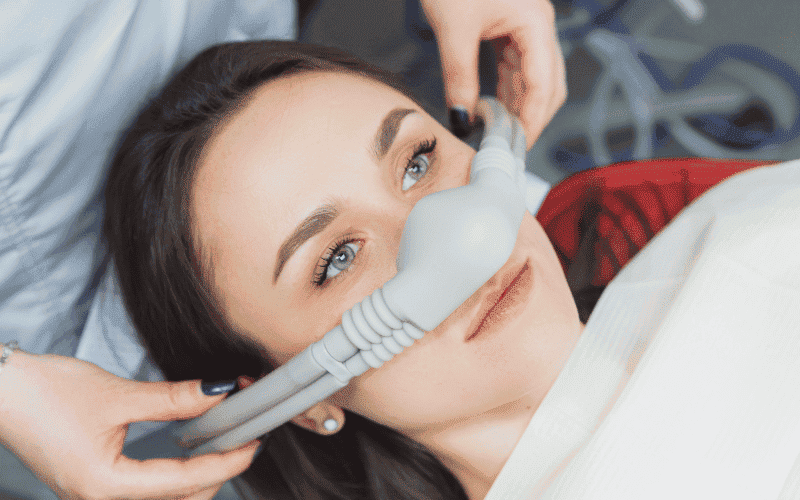Dental implant surgery can be invasive and may require sedation to ensure patient comfort and relaxation throughout the procedure. Sedation options vary, ranging from local anesthesia to general anesthesia, depending on the complexity of the surgery and the patient’s anxiety levels. This blog will delve into the various sedation methods used for dental implant surgery, helping readers decide which option best suits their needs. Sedations Used For Dental Implants will be the primary focus, addressing their significance and suitability for different patient scenarios.
Types of Sedation for Dental Implants
A. Local Anesthesia
Local anesthesia works by blocking nerve signals in a specific body area, numbing the targeted region, and preventing pain sensations during dental procedures. It typically contains anesthetic agents like lidocaine or articaine, which temporarily disrupt nerve impulses.
When injected near the treatment site, local anesthesia numbs the tooth and surrounding tissues, including the gums and jawbone. This allows the dentist to perform dental implant surgery comfortably while the patient remains awake and aware and experiences minimal discomfort.
Local anesthesia is an effective option for managing pain during dental implant placement.
B. Conscious Sedation
Conscious sedation induces a state of relaxation and reduces anxiety in dental procedures while allowing the patient to remain conscious and responsive. It involves administering medications that depress the central nervous system, resulting in a calming effect. Dentistry utilizes several forms of conscious sedation.
1. Oral Sedation: This involves ingesting oral medications, typically benzodiazepines such as diazepam (Valium) or lorazepam (Ativan), before the dental procedure. These medications are usually taken about an hour before the appointment to induce a relaxed state. Depending on the dosage administered, oral sedation can range from minimal to moderate.
2. Nitrous Oxide Sedation (Laughing Gas): Nitrous oxide, mixed with oxygen, is inhaled through a mask placed over the nose. It induces euphoria and relaxation, hence its colloquial name, “laughing gas.” Nitrous oxide sedation is fast-acting and wears off quickly, allowing patients to drive themselves home after the procedure.
3. Intravenous (IV) Sedation: Intravenous sedation is the process of injecting sedative medications directly into the bloodstream via a vein. This method allows for precise control of the sedative effects and can achieve a deeper level of sedation than oral or nitrous oxide. IV sedation is commonly used in more complex dental procedures or for patients with severe anxiety.
C. General Anesthesia
Administering medications that suppress the central nervous system induces a state of unconsciousness known as general anesthesia. Unlike conscious sedation, where the patient remains awake and responsive, general anesthesia renders the patient completely unconscious and unaware of the dental procedure. It is typically used for complex or lengthy surgeries requiring deep sedation.
Under general anesthesia, patients lose all sensation and awareness, allowing the dental team to perform the procedure without causing discomfort or distress. However, general anesthesia carries risks such as respiratory depression and cardiovascular complications, requiring careful monitoring by trained anesthesia professionals throughout the procedure.
Factors Affecting Choice of Sedations For Dental Implants
The choice of sedation for dental implant surgery depends on several factors:
1. Complexity of the implant procedure: More complex surgeries may require more profound levels of sedation or even general anesthesia to ensure patient comfort and safety during the procedure.
2. Patient’s anxiety level: Patients with high levels of anxiety may benefit from more profound levels of sedation or general anesthesia to help them relax and alleviate fear or discomfort associated with the surgery.
3. Patient’s medical history: Medical conditions such as cardiovascular issues, respiratory disorders, or allergies to specific medications may influence the choice of anesthesia. Patients with certain medical conditions may require special considerations or precautions when selecting the appropriate anesthesia option.
Wrap Up!
In conclusion, selecting the right sedation option for dental implants is crucial for ensuring a comfortable and stress-free experience during dental implant surgery. At Missouri City Dentist—Excel Dental, our team understands the importance of personalized care. We will carefully assess your needs, anxiety levels, and medical history to determine the most suitable sedation option for you.
For local, conscious, or general anesthesia, your safety and comfort are our top priorities. Rest assured, we’ve got you covered. Recovery expectations may vary based on the different types of sedations used after dental implants, but our team will provide thorough guidance and support every step of the way. Contact us today to schedule your consultation!


